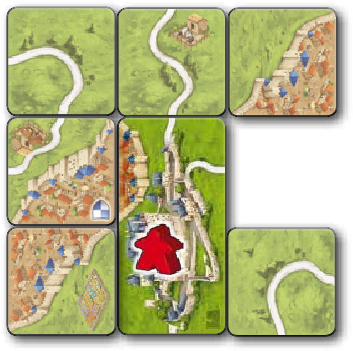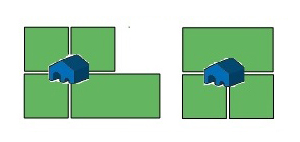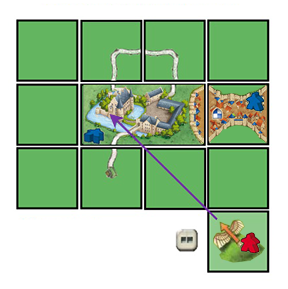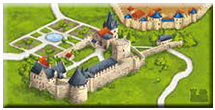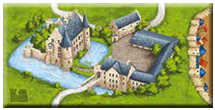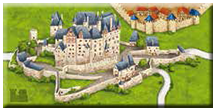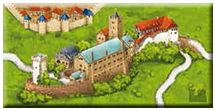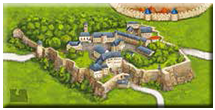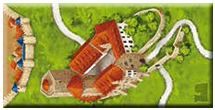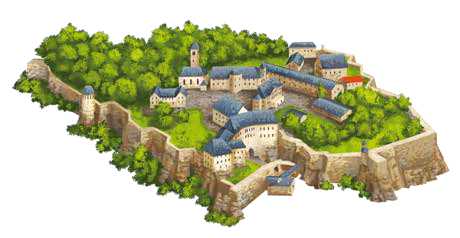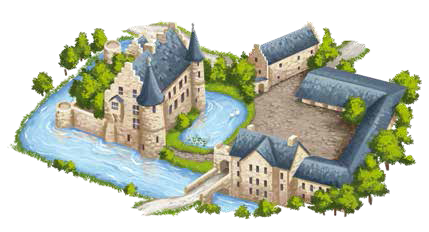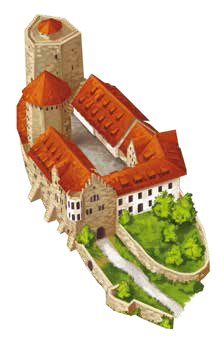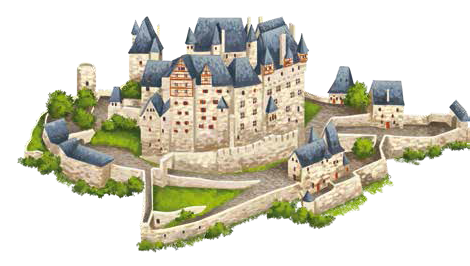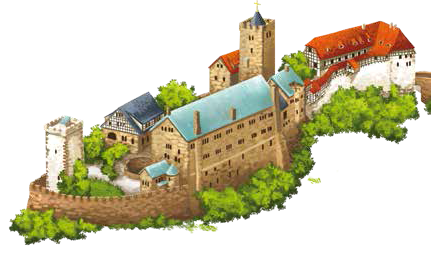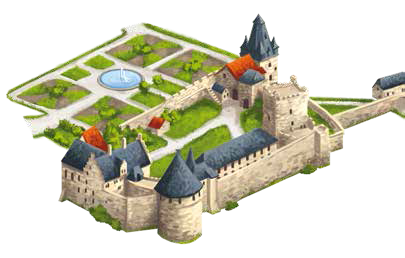Difference between revisions of "Castles in Germany/ro"
m |
(Created page with "500px|Castelul Konradsheim (Renania de Nord-Westfalia)") |
||
| Line 161: | Line 161: | ||
----- | ----- | ||
[[File:German_Castles_C2_Castle_Image_02.png|500px|Konradsheim | [[File:German_Castles_C2_Castle_Image_02.png|500px|Castelul Konradsheim (Renania de Nord-Westfalia)]] | ||
'''Konradsheim Castle''' (North Rhine-Westphalia) | '''Konradsheim Castle''' (North Rhine-Westphalia) | ||
Revision as of 20:16, 4 June 2020
Informații generale și comentarii
Miniextensia Castele din Germania (Burgen in Deutschland) a fost lansată în ediție nouă în anul Template:Year ro de HiG. Această miniextensie a fost lansată în ediție veche în anul Template:Year ro.
Această miniextensie, care prezintă 6 castele binecunoscute din Germania, permite jucătorii să stăpânească castele, câștigând puncte extra pentru proprietățiile lor faimoase.
Această miniextensie a fost dezvoltată pentru jocul de bază Carcassonne.Toate regulile jocului de bază încă se aplică în adiție cu regulile miniextensiei de mai jos. O poți combina cu alte (mini)extensii - dar pe riscul propriu – asta este, nu vor exista reguli oficiale pentru aceste combinații.
Conținut
- 6 cartonașe de teren de mărime dublă reprezentând castele germane
Reguli
Pregătire
Fiecare jucător ia un castel la alegerea sa. Când jucați cu doi sau trei jucători, puteți lua fiecare câte 2 castele. Alternativ, poți amesteca cartonașele cu castele și să le distribui. Apoi îți plasezi cartonașul/cartonașele cu castel(e) în fața ta.
1. Placing a tile
Instead of taking a Land tile from the draw pile players are allowed to place one of their castles. Note that a Castle tile must not touch another Castle tile, neither directly nor with the edges (diagonally). All other placing rules stay the same as in the basic game.
2. Placing a meeple
Having placed their Castle tile, players are allowed to place a meeple. They may place the meeple on a road, city, or field or as lord in the castle.
Declanșarea unei evaluări
Evaluarea unui castel finalizat
A castle can be completed and scored the same way as monasteries. As soon as the castle is surrounded by other Land tiles, you, the lord gets 12 points and take your meeple back to your stash.
At the end of the game all Land tiles surrounding an incomplete castle score one point. The Castle tile itself counts as 2 points.
Scoring roads and cities around a castle [1] [2]
If a road or a city which ends on the Castle tile is completed, players get bonus points. Each player who gets points gets 3 bonus points for each castle which is involved. [3] [4] It does not make any difference if the castle is occupied or not.
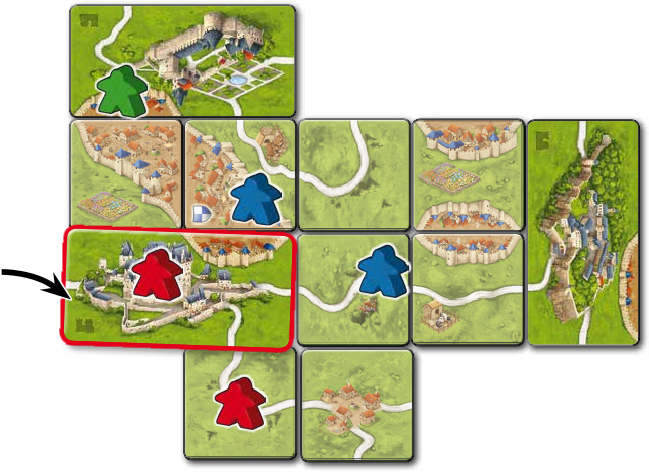
- You place the castle in the bottom left corner and place a meeple inside on it. You complete 2 roads and 1 city by doing that.
- Green and Blue get 16 points for their city. (10 points for the city and 2 x 3 points for the castles)
- You get 6 points for your road (3 points for the road and 3 points for the castle)
- Blue gets 10 points for his road (4 points for the road and 2 x 3 points for the castles)
La sfârșitul jocului, nu se acordă puncte bonus pentru drumuri sau orașe.
Alte extensii
>> Considerații generale
- This section covers clarifications regarding the interaction of German castles with other expansions (from 10/2015)
>> Hanuri și catedrale - Puncte bonus
- Scoring first takes place for roads with an inn or a city with a cathedral, and then the +3 bonus from any German castle is added.
>> Prințesa și dragonul - Mutarea dragonului
- German castles do not protect followers from the dragon. The German castle is on one tile, so it has less functions than a castle (from Bridges, Castles and Bazaars) that sits between 2 tiles. The function or the mechanics of the German castle is more like those of a monastery.
- The German castle tile is one single tile - so the dragon needs only one of his 6 moves for this tile and then continues on its way.
>> Turnul - Area turnului
- German castles count as one tile for the tower range.
>> Abația și primarul - Partea 1: Mutarea căruței
- The wagon can be placed on a German castle.
- The wagon can be driven to a German castle after completing a road that is connected to the German castle - as long as the German castle is not finished and no other follower owns it.
>> Abația și primarul - Partea 2: Plasarea moșiei
- The general rule states that the base for the barn has to be stable - that means that the corner of all four tiles have to touch each other and all tiles must have field in the corner for the placement of the barn.
- A German castle tile can therefore occupy one or two of the corners under the barn
>> Aparate de zbor - Distanța de zbor și plasarea
- The German castle counts as 1 tile. If the flier lands on this tile then the flier has the choice of 3 roads, 1 city or the German Castle (the function or the mechanics of the German Castle is more like those of a monastery.) The flier can only land on one of these features if it is not yet finished.
- If the flight of the flier is diagonal, all steps must be in a straight line in the direction the arrow shows from the flying machine tile. The angle cannot change but it would if it had entered via one corner of the German castle tile, and exited via the opposite corner. If the flier lands on the German castle tile then the flier has the choice of 3 roads, 1 city or the German Castle. The flier can only land on one of these features if it is not yet finished.
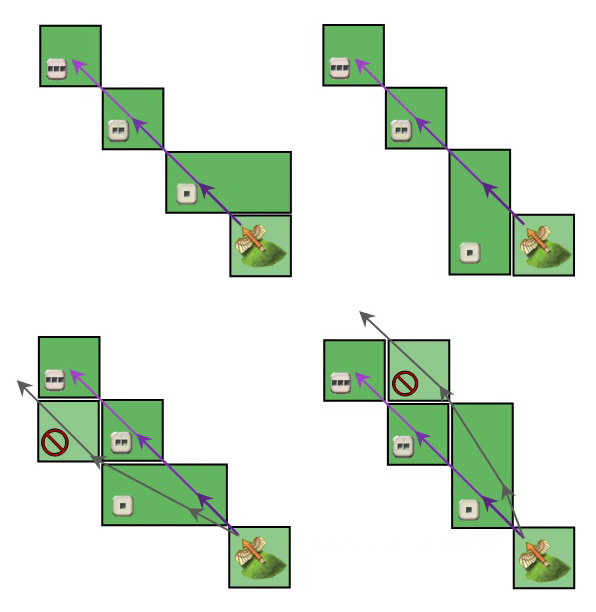 Example F2: These examples show a diagonal flier trajectory involving German castle tiles. The violet arrow indicates the correct trajectory following the flying machine direction. The grey arrow shows an invalid diagonal trajectory as it deviates from the trajectory indicated by the flying machine.
Example F2: These examples show a diagonal flier trajectory involving German castle tiles. The violet arrow indicates the correct trajectory following the flying machine direction. The grey arrow shows an invalid diagonal trajectory as it deviates from the trajectory indicated by the flying machine.
>> Ciuma - Răspândirea ciumei
- A German castle counts as 1 tile for the plague tokens.
>> Mănăstiri din Germania și Construcții japoneze / Mănăstiri din Germania/Olanda & Belgia - Evaluarea starețului
- There is no explicit clarification on how German castles affect the scoring of the abbot on a Monastery. It seems reasonable to apply the principles provided for The Tower above.
Referință pentru cartonașe
Numărul total de cartonașe: 6
Castelele în detaliu
Fortăreața Königstein (Saxonia)
This castle is one of Europe's biggest hilltop fortresses. It is situated in Saxon Switzerland in the Elbe Sandstone Mountains near Dresden. The fortress was built on top of a rock plateau 240 meters above the river Elbe. Over a period of more than 750 years, this place became an impressive ensemble of buildings of the late gothic period, the renaissance, the baroque and the 19th century.
http://www.festung-koenigstein.de
Konradsheim Castle (North Rhine-Westphalia)
This water castle is situated between Cologne and Bonn and is one of the few castles of the late Middle Ages in the Rhineland still preserved. The knight Arnold von Buschfeld is said to be the builder of this castle. First mentioned in a document in 1337, the castle is nowadays private property and can be rented for events.
http://www.burg-konradsheim.de
Rieneck Castle (Bavaria)
This castle was built around 1150 near the town of Rieneck above the river Sinn in Lower Franconia in Bavaria. Today, the castle serves as a scouting facility and is owned by the German Christian Guide and Scout Association. Particularly well known – and the centrepiece of the castle – is the “Thick Tower“ built in the 12th century with his romantic wall chapel constructed completely enclosed by the keep's wall.
http://www.burg-rieneck.de
Eltz Castle (Rhineland-Palatinate)
It is considered the paragon of German castles. It is situated in the Eltz river valley near the Eifel. It was built in the beginning of the 12th century and has yet never been destroyed. Eltz castle has a history full of myths, luminaries and distinguished art.
http://www.burg-eltz.de
Wartburg Castle (Thuringia)
The Wartburg (Burg: german castle) is situated above the city of Eisenach in Thuringia. Built around 1067 under Louis the Springer ("the Jumper") the castle is – since 1999 – a UNESCO World heritage site. Between May 1521 and March 1522 Martin Luther, who had found shelter inside the Wartburg, translated the New Testament into German.
http://www.wartburg.de
Bentheim Castle (Lower Saxony)
This is a castle complex in the middle of the city of Bad Bentheim in Lower Saxony, which has been built in the Early Middle Ages. First mentioned in a document in the 11th century it is believed to be one of the largest and most beautiful castle complexes in north-western Germany. Nowadays, the castles museum can be visited year-round.
http://www.burg-bentheim.de
Note de subsol
Pentru licențierea și semnificația pictogramelor te rugăm să vizitezi Pagina pictogramelor.
- ↑
 Question: How many points does a German castle count for monastery scoring? Answer: Since, monasteries are scored according to the occupied spaces by the monastery itself and its adjacent spaces, a German castle tile counts as the number of spaces it occupies: 1 or 2 depending of its placement relative to the monastery. (4/2020)
Question: How many points does a German castle count for monastery scoring? Answer: Since, monasteries are scored according to the occupied spaces by the monastery itself and its adjacent spaces, a German castle tile counts as the number of spaces it occupies: 1 or 2 depending of its placement relative to the monastery. (4/2020)
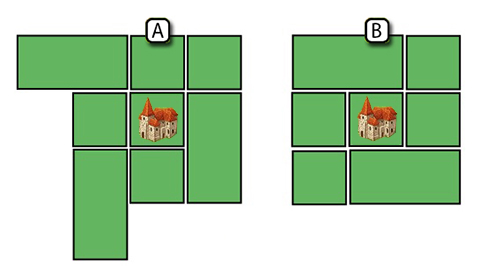 Examples of monastery scoring with German castles. The player gets 1 point for the monastery tile and 1 point per occupied space around it, no matter if it is a square tile or part of a double-sized tile:
Examples of monastery scoring with German castles. The player gets 1 point for the monastery tile and 1 point per occupied space around it, no matter if it is a square tile or part of a double-sized tile:- Example A: This completed monastery scores 9 points, with 3 German castles in its vicinity.
- Example B: This completed monastery scores 9 points, with 2 German castles in its vicinity.
- ↑
 Question: Does a German castle count for field scoring? Answer: No, it doesn't count for field scoring. The German castle is on one tile, so its has less functions than a castle that sits between two tiles. (10/2015)
Question: Does a German castle count for field scoring? Answer: No, it doesn't count for field scoring. The German castle is on one tile, so its has less functions than a castle that sits between two tiles. (10/2015)
- ↑
 Thus, a road that had each end on a different castle tile would score 6 bonus points. A road that began and ended on the same castle tile would receive 3 bonus points. (4/2015)
Thus, a road that had each end on a different castle tile would score 6 bonus points. A road that began and ended on the same castle tile would receive 3 bonus points. (4/2015)
- ↑
 These bonus points are added to the feature score after modifications from inns or cathedrals. (10/2015)
These bonus points are added to the feature score after modifications from inns or cathedrals. (10/2015)
- Editor Manual - Old numbered parameters - RulesPlacingTile
- Editor Manual - Old numbered parameters - RulesPlacingMeeple
- Editor Manual - Old numbered parameters - RulesScoring
- Editor Manual - Old numbered parameters - Tile
- Old template
- Old template - FootnoteIconPara ro
- Category:A doua ediție
- Category:Extensii minore din a doua ediție

